18 Best Stretching Exercises For Shoulder
Table of Contents
Introduction
Yoga positions and mild stretches are among the exercises that can help strengthen and improve the shoulder muscles and reduce pain.
- Shut your eyes, inhale deeply, and focus your attention on your shoulders, feeling their sensation.
- You’ll likely have some discomfort, tenseness, or other sensations here.
- 18 to 26 percent of persons experience shoulder pain or tightness regularly.
- Luckily, there are things you can do to ease shoulder pain.
- Continue reading to find out how to perform ten easy shoulder exercises to release tension and discomfort.
- Along with increasing your range of motion and enhancing your flexibility, these strengthening and lengthening exercises will also make your movements more comfortable and effortless.
Tips for these exercises
- To reduce shoulder pain, perform these easy exercises three to six times a week.
- As you become stronger and more flexible, gradually extend the duration of your 10-minute program.
- As you perform these exercises, pay close attention to your shoulders and other tight spots.
- Only extend as far as is comfortable on any given day.
- Don’t push yourself over your comfort zone, and stop the workouts if you feel more pain than light discomfort.
Best Stretching Exercises For Shoulder
Across-the-chest stretch
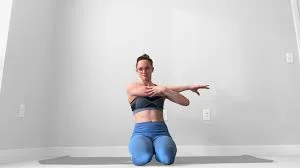
Your shoulder joint and the surrounding muscles will become more flexible and have a wider range of motion after performing this exercise. If you have shoulder soreness after this exercise, lower your arm.
Steps To Follow:
- Spread your right arm above your chest.
- Either place it in the bend of your left elbow or support your arm with your left hand.
- Hold this position for a full minute.
- On the other side, repeat.
- Repeat 3-5 times on each side.
Neck release
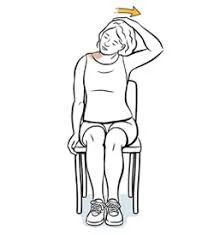
It’s possible to gently release tension in your shoulders and neck by performing this exercise.
Steps To Follow:
- Lower your chin about your chest.
- A stretch along the back of your neck will be experienced.
- To extend your right shoulder, gently cock your head to the left.
- Hold this position for a full minute.
- On the other side, repeat.
- Repeat 3-5 times on each side.
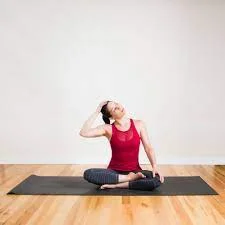
To extend this span more:
Steps To Follow:
- To gently direct the movement, place one hand over your ear and one on your shoulder.
- Drop your chin about your chest.
- An extension along the back of your neck will be experienced.
- To extend your right shoulder, gently cock your head to the left.
- Hold this position for a full minute.
- On the other side, repeat.
- Repeat 3-5 times on each side.
Chest expansion
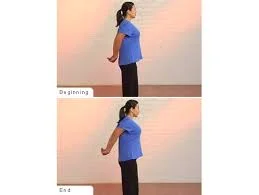
Your shoulders’ range of motion as well as their flexibility will be improved by this workout.
Steps To Follow:
- While standing, use both hands to grasp an exercise band, strap, or piece of fabric behind your back.
- Spread out over your chest while you bring your shoulder blades closer to one another.
- Raise your chin and cast your attention upward.
- As long as 30 seconds, hold.
- 3 to 5 times over.
Eagle arms spinal rolls
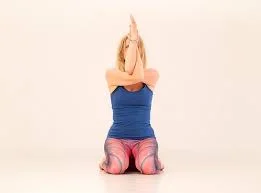
Your shoulder muscles will be stretched by this workout. Use opposing shoulders for this exercise if the arm position is bothersome.
Steps To Follow:
- Seated, extend your arms to the sides.
- Stack your right arm on top as you cross your elbows in front of your body.
- Bend your elbows and bring your hands and forearms together.
- Bring your palms together by stretching your right hand around.
- Keep your posture for 15 seconds.
- As you pull your elbows in towards your chest and release the air, roll your spine.
- As you take a breath, expand your chest and raise your arms.
- Keep up this motion for a minute.
- On the other side, repeat.
Seated twist
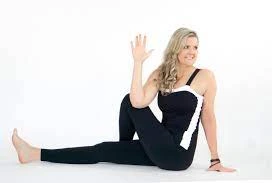
You can stretch your neck and shoulders with this workout. Throughout this exercise, maintain your hips facing forward. Start with your lower back and let the twist begin.
Steps To Follow:
- Place your ankles exactly above your knees while seated in a chair.
- Bring the back of your left hand to your thigh while rotating your upper body to the right.
- Put your right hand down in a comfortable spot.
- As long as 30 seconds, maintain this posture.
- On the left side, repeat.
- Repeat 3-5 times on each side.
Shoulder circles
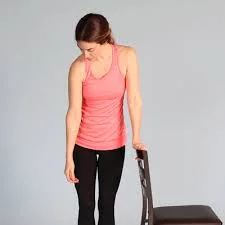
You can increase flexibility and warm up your shoulder joints with this exercise.
Steps To Follow:
- Place your left hand under a chair while you stand there.
- Let your right hand swing down.
- Make 5 circles with your right hand in each direction.
- On the other side, repeat.
- Repeat two to three times a day.
Doorway shoulder stretch
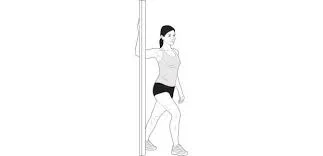
This exercise strengthens your shoulders and opens your chest.
Steps To Follow:
- Make a 90-degree angle with your arms and elbows while you stand in a doorway.
- Press your palms into the door frame’s sides and step your right foot forward.
- Lie forward and contract your abs.
- As long as 30 seconds, maintain this posture.
- Stretch again by placing your left foot forward.
- Repeat each side 3 times.
Downward Dog Pose
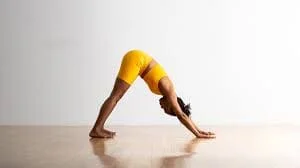
Your back and shoulder muscles are stretched and strengthened by this inversion stance.
Steps To Follow:
- Get on your hands and knees to begin. Raise your hips to the ceiling by applying pressure with your hands.
- When you equally distribute your weight into your hands and feet, keep your knees slightly bent.
- Bring your head towards your feet to bend your shoulders overhead while maintaining a straight spine.
- Take a minute or so to maintain this stance.
Child’s Pose

This balancing stance reduces stiffness in your neck, shoulders, and back. For support, place a pillow beneath your legs, chest, or forehead.
Steps To Follow:
- In Downward Dog Pose, bring your big toes together and your knees slightly wider than your hips.
- With your arms out in front of you, drop your hips back onto your heels.
- Relax your shoulders and spine by letting your chest drop heavily to the floor.
- Hold this position for 5 minutes at most.
Thread the needle
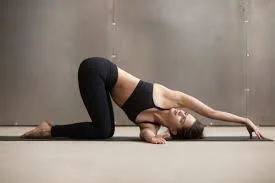
You can release tightness in your upper back, shoulders, and chest by using this pose. For support, place a block or pillow under your shoulder or head.
Steps To Follow:
- Get on your hands and knees to begin.
- With your palm facing away from your body, raise your right hand towards the ceiling.
- With your palm facing up, lower your arm so that it is beneath your chest and on the left side of your body.
- To keep yourself from stumbling into this position, move your right shoulder and arm.
- You can either raise your left hand to the ceiling, keep it on the floor for support, or bring it around to the inside of your right thigh.
- As long as 30 seconds, maintain this posture.
- Before completing this stretch on the left side, unwind in Child’s Pose.
Neck stretches
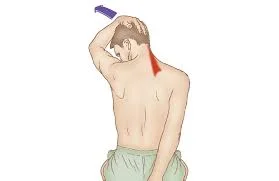
Stretches for the neck can help in releasing tension in the upper shoulders.
Steps To Follow:
- Position your feet hip-width apart.
- Allow the arms to dangle at the sides.
- Aim ahead.
- Try to connect the right shoulder with the right ear by tilting your head to the right.
- Sensate the strain in your left shoulder and neck.
- Try to connect the left shoulder with the left ear by tilting your head to the left.
- Sensate the strain in your right shoulder and neck. Hold the position for ten seconds each time.
- On all sides, repeat this 3 times.
Shoulder rolls
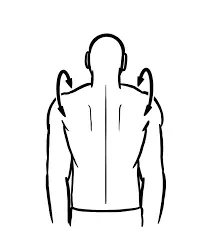
An easy position to extend your shoulders is to perform shoulder rolls.
Steps To Follow:
- Position your feet hip-width apart.
- Arms should be relaxed by your sides.
- Breathe deeply and raise your shoulders to your ears.
- Squeeze the shoulder blades together by repositioning the shoulders.
- Let out a breath and return your shoulders.
- Feel the strain at the back of the shoulders as you forward the elbows.
- 10 times over, repeat this.
Pendulum stretch
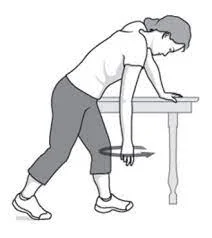
Using the pull of gravity, the pendulum is an easy way to develop shoulder movement.
Steps To Follow:
- Position your feet hip-width apart.
- Look at the ground while bending forward.
- For support, rest the right hand on a chair or table.
- Allow the left arm to dangle.
- With your left arm, slowly swing it in little circles, allowing gravity to take care of the majority of the effort.
- Continue for a duration of 30 to 60 seconds.
- Modify the motion’s direction.
- Utilizing the other arm, repeat this.
Cross-body arm swings
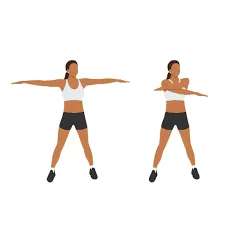
Swinging your arms back and forth helps loosen up and warm up the shoulder joint.
Steps To Follow:
- Position your feet hip-width apart.
- Squeeze the shoulder blades together as you take a breath and raise your arms to the sides.
- Breathe out and softly move your arms in close to one another.
- Maintaining straight arms, cross the right arm beneath the left.
- Squeeze the shoulder blades together while taking a breath and swinging the arms back out to the sides.
- After letting out a breath, slowly bring your arms back towards each other.
- Keeping both arms straight, cross the left arm beneath the right this time.
- 10 times over, repeat this.
Cross-body shoulder stretch

Stretching the rear of the shoulder is aided by the cross-body shoulder stretch.
Steps To Follow:
- Position your feet hip-width apart.
- Stretch your right arm straight out.
- With the hand pointing to the floor on the opposite side of the left leg, bring the right arm across the torso.
- Bend the elbow of your left arm.
- To support the right arm above the elbow, hook the left forearm under the right arm.
- To extend the back of the right shoulder, pull the right arm farther in and across the body with your left forearm.
- After 20 seconds of holding this, switch to the other side and repeat the stretch.
Ragdoll Pose
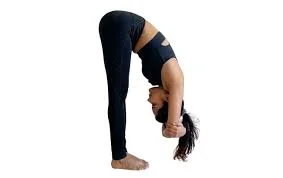
A forward-bend yoga practice called Ragdoll practice may help reduce shoulder tightness.
Steps To Follow:
- Position your feet hip-width apart.
- Slightly bend your knees.
- Try reaching forward and touching your toes.
- To support the lower back, press your tummy against your bent legs.
- Put both hands on the opposing arm’s elbow.
- The top of the head ought to be facing downward.
- To ease stress on the shoulders and neck, let the head hang freely.
- Maintain this stance for a minimum of one minute.
Cow Face pose
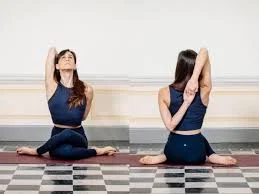
A yoga practice that stretches the shoulders is Cow Face.
Steps To Follow:
- Position your feet hip-width apart.
- Lift your right arm straight up and towards the sky.
- Bend the elbow of your right arm.
- Raise your elbow and extend your right hand over your head and down your back.
- Lower your left arm towards the floor.
- Raise your left hand up and behind you.
- Bring the right and left hands together; if it is comfortable, clasp them.
- Inhale deeply three or four times.
- Repeat on the other side after releasing the stretch.
Side-lying thoracic rotation
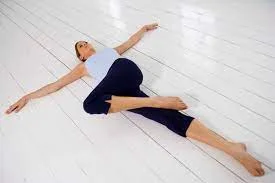
Although the side-lying chest rotation seems difficult, it is simple to perform. This shoulder stretch aids in enhancing lumbar, thoracic, and shoulder movement.
Steps To Follow:
- Lie on your right side either on a mat or the ground.
- Slightly bend your knees.
- Stretch your right arm straight forward.
- It is appropriate to place the left hand over the right.
- Maintain a focused look on the left hand.
- Raise your left hand vertically.
- As though creating an arch in the air, rotate the left arm towards the floor behind the back.
- Throughout, maintain a right-pointing posture with your hips and knees.
- Return the left arm to the right hand’s side.
- Make numerous repetitions of the drawing action.
- Practice it on the opposite side after that.
Benefits of Stretching Exercises For Shoulder
A muscle’s fibers and the surrounding fascia, or bands of connective tissue, both extend to their maximum length during a stretch. This increases the muscle’s and fascia’s capacity to stretch during movement.
There are several possible health benefits to stretching your shoulders. stretching a can:
- reduce tension
- relieve pain
- increase mobility
- lessen the possibility of joint and muscle damage
- improve posture
According to research, stretching on its own can help persons with constant neck discomfort just as much as stretching in conjunction with strength training. Pain can result from stress in the shoulders.
A 2015 small-scale study discovered that neck and shoulder pain could be decreased with a regular 4-week stretching regimen. Researchers found that office workers with chronic, moderate-to-severe neck discomfort reported better neck function and a higher quality of life after participation in the stretching program.
What causes tight shoulders?
Shoulder tension can be caused by:
- improper posture
- sitting for long periods
- using an improperly positioned laptop or desktop
- the overuse of a cell phone
- stress
- carrying heavy bags
- injury
- arthritis
Shoulder tension may worsen with age.
Preventing shoulder pain and tightness
- Regular stretching can assist in avoiding the development of shoulder tension in the first place.
- Exercise regularly is also crucial. Yoga may aid in lowering tension and stress while boosting flexibility.
- Use a stand to raise the computer screen to eye level while working at it.
- This lessens the chance of shoulder stress and the necessity to hunch the neck and shoulders.
- Keeping proper posture is also crucial. The above shoulder roll exercise can assist in realigning the shoulders if someone feels that they are slouching.
- Long-term shoulder and neck stress can be decreased by maintaining proper posture when standing and sitting, especially when working at a desk for extended periods.
Conclusion
One typical complaint is shoulder soreness. This joint is prone to damage due to its distinct structure and range of motion. Accidents, repetitive motion, manual labor, sports, and aging are common injury triggers.
Severe pain from an injury necessitates emergency care. In addition, any joint deformity, abrupt swelling, incapacity to use the joint, numbness or paralysis in the hands or arms, or unbearable pain should be promptly addressed by a physician. One method to get the most out of your workouts is to be aware of your heart rate zones while exercising.
Heart rate zones show you how hard your body is working by representing various percentages of your maximal heart rate. Though these measurements can be helpful, it’s crucial to remember that many automatic trackers won’t account for things like genetics or medications that may have an impact on heart rate. It’s wise to speak with a doctor before starting any new fitness regimen. They can provide you with tailored guidance to make sure you’re exercising safely.
FAQ
This is a very important concept that needs to be applied five times a day, every day, softly. Stretching increases the range of motion and eases excruciating shoulder tightness.
Place your arms at your sides and your feet hip-width apart as you stand. With your right hand, reach across your body with your left arm and grasp your left elbow. Till your left shoulder feels stretched, slowly bring your left elbow up to your chest. After 30 seconds of holding, swap sides.
The dumbbell shoulder press is the finest exercise for targeting the front of the shoulders, while the seated rear lateral raise or the 45-degree incline row is the ideal exercise for targeting the back of the shoulders.
Your shoulders will naturally slide forward when you sleep prone, relieving some of the weight and maybe preventing shoulder blade pain. Keep your arms by your sides when you sleep. When lying down, try not to lift your arm over your head.
They strengthen the shoulders, pectoral muscles, and triceps. By contracting (drawing in) the abdominal muscles, they can also strengthen the core and lower back when done correctly. Push-ups are a quick and efficient strength-training exercise.
References
- Burgess, L. (2024, January 22). Top 10 stretches for shoulder tightness. https://www.medicalnewstoday.com/articles/324647#prevention
- Cronkleton, E. (2023, February 3). Top 10 Exercises to Relieve Shoulder Pain and Tightness. Healthline. https://www.healthline.com/health/shoulder-pain-exercises

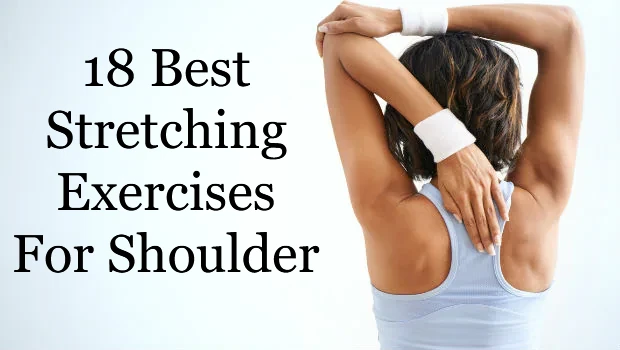
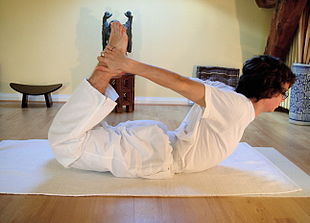
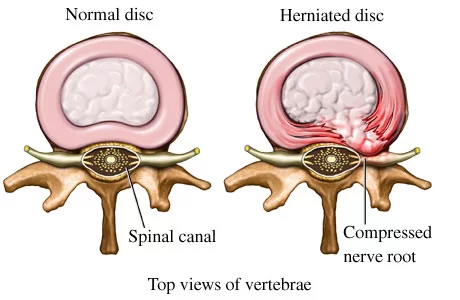
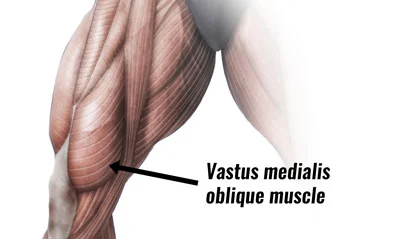
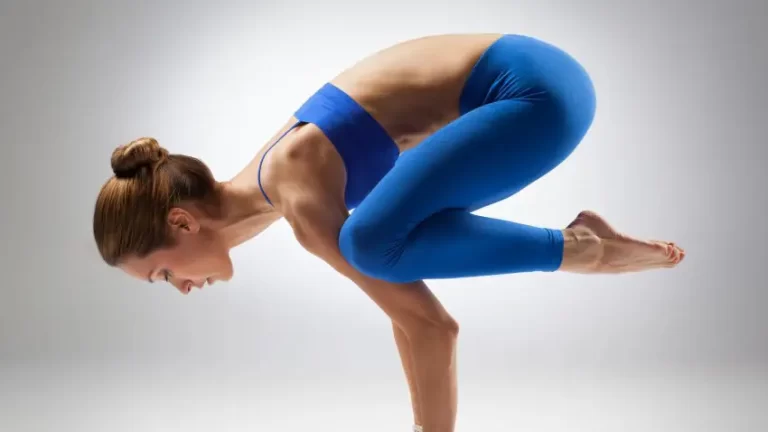
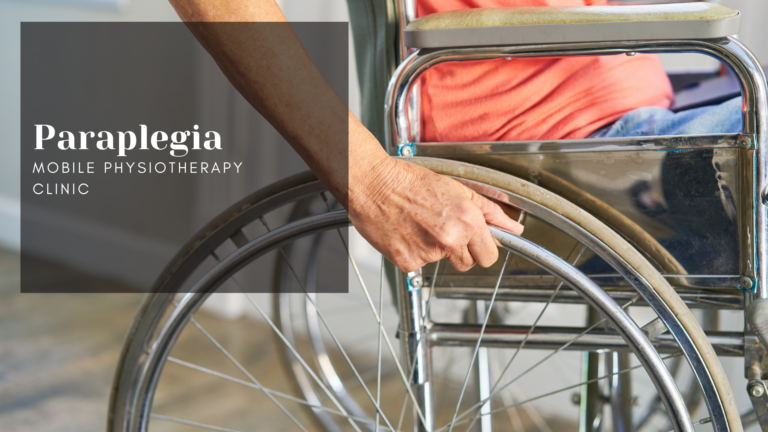

One Comment